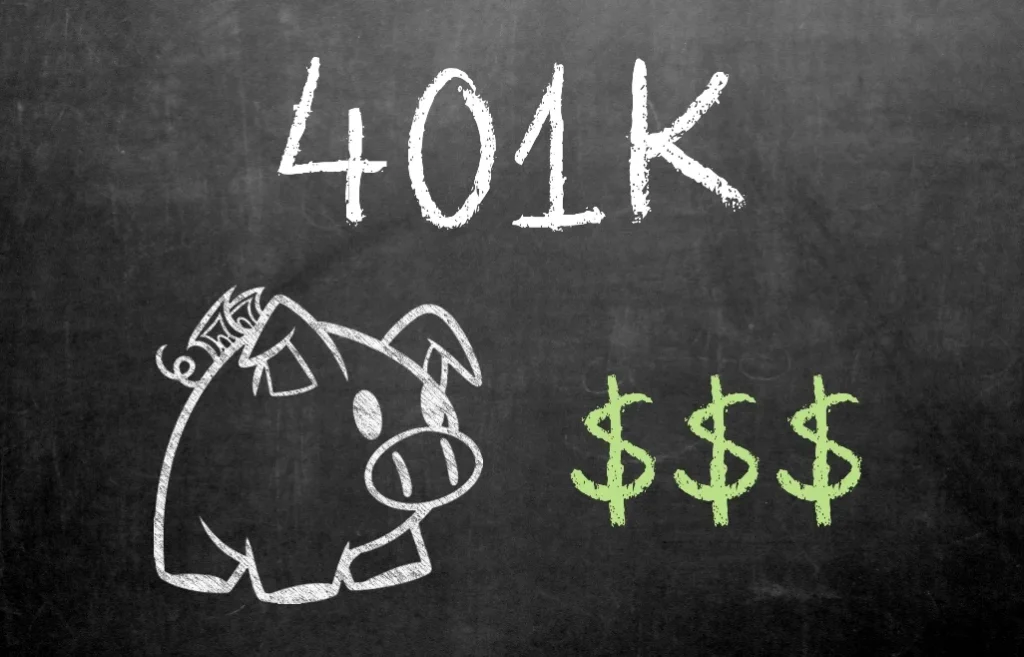No matter how old you are, it’s never too early to start thinking about and actively saving for retirement. With all the reports of America’s severe retirement savings gap, it seems that most Americans are far less prepared for this life event.
If your employer offers a 401(k) plan where you work, it’s a great way to start (or continue) saving for your golden years. Before you join, figure out exactly what a 401(k) is and how it can help you prepare for retirement. If you’re already in a 401(k) plan, make sure you know what to expect when it’s time to retire.

How does a 401(k) work?
A 401(k) plan helps you save while investing in various mutual funds. Employers offer this type of retirement plan, so you can’t sign up for it unless you’ve been to your place of employment.
To encourage saving, you can take advantage of tax benefits. Depending on the type of 401(k) you choose (or the type offered by your company), you can get a tax break on contributions or withdrawals.
Employer 401(k) Matching
Many employers will offer a match based on your contributions. This usually happens in one of two ways:They either match dollar-for-dollar up to a certain limit, or they match a percentage of your salary.
The most common type of 401(k), the traditional 401(k), allows you to make any tax-deductible contributions each year. So if you contribute $6,000 a year, you can deduct that amount from your taxable income. If you’re on the edge of one tax bracket and contribute a sizable amount to your 401(k) pension, you can even jump to another bracket with a lower tax rate.
401(k) Tax Rules
While your investments grow each year, they remain temporarily protected from taxes. Unlike other types of investments, you don’t pay any annual taxes on your 401(k) income until you start making withdrawals. At that point, when you take money out each month, you pay a fixed amount of income tax.
As you continue to pay into your 401(k) throughout the year, you can adjust your investments so that they become more and more volatile. The idea is that as you approach retirement age, your risk of making sure you have a solid savings when you need it decreases.
What’s The Benefits of a 401(k)?
A 401(k) is an employer-sponsored retirement savings plan. It allows employees to save a portion of their paycheck for investment before taxes are deducted.Contributions to a 401(k) plan are pre-tax, which can lower your taxable income for the year and may result in a lower tax bill.
Some other benefits of a 401(k) include:
- Employer matching contributions: Many employers will match a portion of their employees’ 401(k) contributions, effectively giving you free money to save for retirement.
- Tax-deferred growth: Any investment earnings on your 401(k) account grow tax-free until you withdraw the money in retirement.
- Potential for tax credits: Depending on your income and participation in a 401(k) or other qualified retirement plan, you may be eligible for certain tax credits that can help reduce your tax liability.
- Retirement income: A 401(k) can provide a source of income in retirement, which can help you maintain your standard of living when you are no longer working.
- Convenience: Many 401(k) plans offer a range of investment options, and the contributions are automatically deducted from your paycheck, making it easy to save for the future.
Money withdrawn from a 401(k) plan in retirement is subject to income tax, and 401(k) plans have contribution limits. Overall, however, a 401(k) is a valuable tool for saving for the future and reducing tax obligations.
401(k) Contribution Limits
There are limits to your 401(k):
While this is a great financial tool, the most you can put away per year is $22,500, which equals $1,875 per month if divided monthly. If you’re over 50, you can save up to $30,000 per year ($2,500 per month). These contribution limits are designed so that you can only benefit from so much tax savings each year.
Required Minimum Distributions
Another rule associated with 401(k)s is that you must start taking “required minimum distributions” at some point. This means that once you reach a certain age, you must start withdrawing money from your 401(k) account – and pay taxes on it.
The current rule is that you must start drawing your pension the year you turn 70½. Then, you must take out distributions by December 31 of each following year.The IRS determines your minimum required amount based on your life expectancy. There’s nothing like a government tax agency predicting your life expectancy, is there?
That said, this information can help you determine the tax burden you may face when you eventually retire. While your income may be lower, your deductions may also be lower. After all, you may not have children left at home to claim the deduction. If you’ve paid off your mortgage, you won’t have interest to deduct either.
It’s nice to not have these expenses, but it can be helpful to talk to a tax professional to better understand your taxes, especially in the first year of retirement or required minimum distributions. The more prepared you are, the more financial flexibility you’ll have!
Types Of 401(K) Plan
There are two main types of 401(k) plans: traditional 401(k) plans and Roth 401(k) plans.
A Traditional 401(k) allow you to deposit pre-tax dollars into an account. Your contributions and any investment earnings in the account are tax-deferred. This means that you don’t have to pay taxes on the money until you take it out in retirement. When you take the money out in retirement, it is taxed as ordinary income.
A Roth 401(k) is similar to a traditional 401(k), but contributions are paid with after-tax dollars. This means that you don’t get an immediate tax deduction for your contributions, but eligible withdrawals from the account after retirement are tax-free.
Some 401(k) plans may offer both traditional and Roth options, giving you the flexibility to choose the type of plan that best meets your needs.
There are also 401(k) plans designed for specific types of employers, such as Safe Harbor 401(k) plans and Simple 401(k) plans. These plans may have different contribution limits and rules for matching employer contributions. That’s why it’s important to know the details of the insurance plans you participate in.

What’s the Difference Between a Traditional 401(k) And a Roth 401(k)?
While a traditional 401(k) plan allows for early tax savings in exchange for taxes paid in retirement, a Roth 401(k) plan reverses this situation. Instead, your contributions are paid with your taxable income. In return, you don’t have to pay any taxes when you start taking withdrawals from your account during retirement.
While you miss out on the upfront tax savings, you only pay the initial contribution amount. If you’re paying taxes on your withdrawals, you’re also paying taxes on everything you earn, which hopefully is a lot more than when you started.
Roth 401(k) Requirements
Requirements to qualify for Roth 401(k) benefits.
First, your account must have been open for at least five years. You must also wait until you’re at least 59 ½ years old before you can start receiving a pension, unless you have a disability.
Roth IRAs are especially useful if you’ve accumulated a lot of retirement savings and other investments. While many people will have less income in retirement, this is not always the case. You may have a well-rounded portfolio, in which case it would be better for you if at least some of your withdrawals were not taxed.
If you’re about to retire and expect your tax bracket to drop soon, it may not make sense to use a Roth 401(k) plan now. If you’re earning less now because you’re earlier in your career or have a large tax deduction because of your kids and mortgage, then a Roth 401(k) is a great option.
Like all retirement plans, there are better offerings at different stages of your life. By constantly reevaluating how you contribute to your retirement savings, you can maximize your tax benefits now and in the future.
Employer Contribution Match
Employer contribution matching is a feature of some 401(k) plans, where the employer agrees to contribute a certain amount of money to the employee’s 401(k) account based on the employee’s contributions.
For example, an employer may offer a 50% employer match to an employee who contributes the first 6% of his or her paycheck to the 401(k) account. In this case, the employer would contribute an additional 3% (50% of the employee’s contribution) if the employee deposits 6% of his or her wages into the 401(k).
Employer contributions are a way for employers to encourage employees to save for retirement and provide an additional source of retirement income. Employers can also use contribution matching as a way to attract and retain top talent.
Employer contribution matches may have certain rules and requirements, such as vesting periods, that determine when an employee is fully entitled to employer contributions. Make sure you understand the details of the contribution matching program offered by your employer to take full advantage of this benefit.
What Happens If You Leave Your Job?
Don’t worry. You won’t lose your 401(k) savings if you leave your current employer. There are usually a couple different options available. First, if they allow it, you can leave it in the company plan. You won’t be able to continue contributing or make any changes to your distribution. But you can use it when you’re ready to retire.
401(k) Rollover
Or you can do a rollover :
A rollover allows you to transfer funds to another retirement plan without paying any tax penalty. You can use an IRA or you can use your new employer’s plan. You do need to make sure your new employer’s plan allows rollovers.
Then you can continue your contributions as usual, following the rules of your new account, whatever it may be. An IRA is always a viable option because you have control over how you invest your money. While annual contributions are capped at $6,500 (or $7,500 if you’re age 50 or older), that cap doesn’t count when you make a rollover of your funds.
The last option for dealing with your 401(k) pension after you leave your job is to cash it out. If you do this, you will be subject to all the associated penalties. These include a 10% early withdrawal penalty and federal and state income taxes. The exception to the early withdrawal penalty is if you are at least 55 years old when you leave your employer.
How Much Should You Contribute to Your 401(k)?
How much you decide to contribute to your 401(k) plan depends on many factors. At a minimum, you should contribute the maximum contribution allowed by your employer. This essentially amounts to free money that you should never give up.
Next, consider your financial situation as a whole. What debt do you have? If you have any high-interest credit card or loan balances, you may want to focus on paying those off before you contribute more to your retirement plan. Debt with a lower interest rate, such as fixed student loans, may be less urgent to pay off.
Furthermore, consider these recommended saving strategies:
Emergency Fund
You’ll probably want a three to six-month emergency fund in case you lose your job or get a sudden illness or injury. Having a large chunk of money stashed away in an easy-to-access savings account can provide you with financial security here and now.
Roth IRA
Once your overall savings plan is in order, it’s time to start thinking about other places to invest for retirement. Before you maximize your traditional 401(k) retirement plan, consider a Roth IRA. This can help you diversify your retirement plan for tax purposes.
Like a Roth 401(k), a Roth IRA lets you pay taxes on your contributions now so you don’t have to pay anything when you withdraw money in retirement. It can certainly help you spread your tax burden over the course of your life.
Still have money left over to invest?
If you do, revisit your 401(k) plan. Remember, you can contribute up to $22,500, so you can certainly put more of your income toward that maximum.

How Else Should You Prepare For Retirement?
Preparing for retirement requires a constant reassessment of your current needs and your future goals. It’s easy to say, “You need to contribute a few thousand dollars a year to make it through retirement,” but the reality is that it’s much harder to do.
Still, saving for retirement is a challenge worth conquering. Even if you’re in your 40s and haven’t started saving yet, you can start today. Once you have a current savings fund that you can use for emergencies, implement these simple tips to prepare for retirement.
For now, worry less about choosing the perfect type of account and focus on the habit of saving for retirement.
Here are some suggestions to get you started:
How to Save Extra Money:
- Reduce your living expenses, one step at a time.
- Save your tax refund in a retirement account.
- Stream TV instead of pay cable.
- Reduce eating out.
- Stay healthy and reduce future medical expenses.
- Pay off high interest debt such as credit cards.
- Sell what you have and save the money for retirement.
How to Strategically Manage Your Retirement Accounts:
- Set a retirement savings goal as a percentage of your income.
- Start by paying yourself by setting up automatic direct deposits to your retirement account on payday.
- Take advantage of higher IRA contribution limits when you’re over 50.
- Audit your accounts annually.
- Consolidate multiple accounts (such as IRAs) to reduce fees.
- Deposit year-end bonuses into retirement accounts.
Bottom Line
Investing in retirement is really about investing in yourself. Utilizing your employer’s 401(k) plan is an important part of this equation. In addition to making regular contributions, be sure to explore all of your retirement funding options. Building a healthy portfolio isn’t difficult, and there are plenty of resources to help you get started.





One Comment